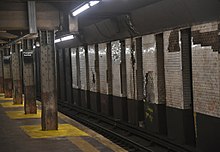
Prospect Avenue station (BMT Fourth Avenue Line)

Prospect Avenue | ||||||||||||||||||||||||||||||||||||||||||||||||||||||||||||||||||||
|---|---|---|---|---|---|---|---|---|---|---|---|---|---|---|---|---|---|---|---|---|---|---|---|---|---|---|---|---|---|---|---|---|---|---|---|---|---|---|---|---|---|---|---|---|---|---|---|---|---|---|---|---|---|---|---|---|---|---|---|---|---|---|---|---|---|---|---|---|
 Southbound platform | ||||||||||||||||||||||||||||||||||||||||||||||||||||||||||||||||||||
| Station statistics | ||||||||||||||||||||||||||||||||||||||||||||||||||||||||||||||||||||
| Address | Prospect Avenue & Fourth Avenue Brooklyn, New York | |||||||||||||||||||||||||||||||||||||||||||||||||||||||||||||||||||
| Borough | Brooklyn | |||||||||||||||||||||||||||||||||||||||||||||||||||||||||||||||||||
| Locale | Gowanus, Greenwood Heights, Park Slope, South Park Slope | |||||||||||||||||||||||||||||||||||||||||||||||||||||||||||||||||||
| Coordinates | 40°39′55″N 73°59′35″W / 40.66528°N 73.99306°W | |||||||||||||||||||||||||||||||||||||||||||||||||||||||||||||||||||
| Division | B (BMT)[1] | |||||||||||||||||||||||||||||||||||||||||||||||||||||||||||||||||||
| Line | BMT Fourth Avenue Line | |||||||||||||||||||||||||||||||||||||||||||||||||||||||||||||||||||
| Services | D N R W | |||||||||||||||||||||||||||||||||||||||||||||||||||||||||||||||||||
| Transit | ||||||||||||||||||||||||||||||||||||||||||||||||||||||||||||||||||||
| Structure | Underground | |||||||||||||||||||||||||||||||||||||||||||||||||||||||||||||||||||
| Platforms | 2 side platforms | |||||||||||||||||||||||||||||||||||||||||||||||||||||||||||||||||||
| Tracks | 4 | |||||||||||||||||||||||||||||||||||||||||||||||||||||||||||||||||||
| Other information | ||||||||||||||||||||||||||||||||||||||||||||||||||||||||||||||||||||
| Opened | June 22, 1915[3] | |||||||||||||||||||||||||||||||||||||||||||||||||||||||||||||||||||
| Closed | June 5, 2017 (reconstruction) | |||||||||||||||||||||||||||||||||||||||||||||||||||||||||||||||||||
| Rebuilt | November 2, 2017 | |||||||||||||||||||||||||||||||||||||||||||||||||||||||||||||||||||
| Opposite- direction transfer | No | |||||||||||||||||||||||||||||||||||||||||||||||||||||||||||||||||||
| Traffic | ||||||||||||||||||||||||||||||||||||||||||||||||||||||||||||||||||||
| 2023 | 1,299,538[4] | |||||||||||||||||||||||||||||||||||||||||||||||||||||||||||||||||||
| Rank | 237 out of 423[4] | |||||||||||||||||||||||||||||||||||||||||||||||||||||||||||||||||||
| ||||||||||||||||||||||||||||||||||||||||||||||||||||||||||||||||||||
| ||||||||||||||||||||||||||||||||||||||||||||||||||||||||||||||||||||
| ||||||||||||||||||||||||||||||||||||||||||||||||||||||||||||||||||||
| ||||||||||||||||||||||||||||||||||||||||||||||||||||||||||||||||||||
| ||||||||||||||||||||||||||||||||||||||||||||||||||||||||||||||||||||
The Prospect Avenue station is a local New York City Subway station on the BMT Fourth Avenue Line in Brooklyn. It is located at Prospect Avenue and Fourth Avenue near the convergence of the Gowanus, Greenwood Heights, Park Slope, and South Park Slope neighborhoods. It is served by the R train at all times. The D and N trains also stop here during late nights, and some rush-hour W trains stop here in the peak direction.

The Prospect Avenue station was constructed as part of the Fourth Avenue Line, which was approved in 1905. Construction on the segment of the line that includes Prospect Avenue started on December 20, 1909, and was completed in May 1912. The station opened on June 22, 1915, as part of the initial portion of the BMT Fourth Avenue Line to 59th Street. The station's platforms were lengthened in 1926–1927,[5] and again during a renovation in 1968–1970.[6] The station was also renovated in 1970 and 2017.

History

Construction
The Prospect Avenue station was constructed as part of the Fourth Avenue Line, the plan for which was initially adopted on June 1, 1905.[7] The Rapid Transit Commission was succeeded on July 1, 1907, by the New York State Public Service Commission (PSC), which approved the plan for the line in late 1907.[8][9] The contract for the section of the line that included the Prospect Avenue station, Route 11A3, which extended from 10th Street to 27th Street, was awarded on May 22, 1908, to the Tidewater Building Company and Thomas B. Bryson for $2,043,162.31 (equivalent to $69,286,000 in 2023). The New York City Board of Estimate approved the contract on October 29, 1909.[8][10] Construction on the segment started on December 20, 1909, and was completed in May 1912.[7]

As part of negotiations between New York City, the Brooklyn Rapid Transit Company (BRT), and the Interborough Rapid Transit Company for the expansion of the city's transit network, the line was leased to a subsidiary of the BRT. The agreement, known as Contract 4 of the Dual Contracts, was signed on March 19, 1913.[8] Prospect Avenue opened on June 22, 1915, as part of an extension of the subway to Coney Island, which included the Fourth Avenue Line north of 59th Street as well as the entire Sea Beach Line.[11][3] The station's opening was marked with a competition between two trains heading from Chambers Street station in Manhattan to the Coney Island station, one heading via the West End Line and the other via the Sea Beach Line; the latter got to Coney Island first.[3]

Renovations
1920s
On June 27, 1922, the New York State Transit Commission commissioned its engineers to examine platform-lengthening plans for 23 stations on the lines of the Brooklyn–Manhattan Transit Corporation (BMT), the successor to the BRT, to accommodate eight-car trains. As part of the project, Prospect Avenue's platforms would have been lengthened from 435 feet (133 m) to 530 feet (160 m).[12][13] Though the Transit Commission ordered the BMT to lengthen these platforms in September 1923, no further progress was made until February 16, 1925, when the New York City Board of Transportation (NYCBOT) commissioned its engineers to examine platform-lengthening plans for this and eleven other stations along the Fourth Avenue Line. It estimated the project would cost $633,000 (equivalent to $10,998,000 in 2023).[14] The NYCBOT received bids for the project on February 25, 1926.[15] The contract was awarded to the Corson Construction Company for $345,021 (equivalent to $5,938,000 in 2023).[16] The extensions opened on August 1, 1927.[5]

1950s and 1960s
The city government took over the BMT's operations on June 1, 1940.[17][18] In July 1959, the New York City Transit Authority (NYCTA) announced that it would install fluorescent lighting at the Prospect Avenue station and five other stations along the Fourth Avenue Line for between $175,000 and $200,000. Bids on the project were to be advertised on August 7, 1959 and completed by fall 1960.[19]

In the 1960s, the NYCTA started a project to lengthen station platforms on its lines in Southern Brooklyn to 615 feet (187 m) to accommodate 10-car trains.[6] On July 14, 1967, the NYCTA awarded a contract to conduct test borings at eleven stations on the Fourth Avenue Line, including Prospect Avenue, to the W. M. Walsh Corporation for $6,585 (equivalent to $60,172 in 2023) in preparation of the construction of platform extensions.[20] The NYCTA issued an invitation for bids on the project to extend the platforms at stations along the Fourth Avenue Line between Pacific Street and 36th Street, including those at Prospect Avenue, on March 28, 1969.[21] Funding for the renovation projects came out of the NYCTA's 1969–1970 Capital Budget, costing $8,177,890 (equivalent to $67,946,000 in 2023) in total.[22]

As part of the renovation project, the station's platforms were extended,[6] and the station's elaborate mosaic tile walls were covered over with 8-by-16-inch (20 by 41 cm) white cinderblock tiles. The latter change, which was also made to 15 other stations on the BMT Broadway and Fourth Avenue Lines, was criticized for being dehumanizing. The NYCTA spokesman stated that the old tiles were in poor condition and that the change was made to improve the appearance of stations and provide uniformity. Furthermore, it did not consider the old mosaics to have "any great artistic merit".[23]

2017
Under the Metropolitan Transportation Authority's 2015–2019 Capital Program, the station, along with thirty other New York City Subway stations, were scheduled to undergo a complete overhaul as part of the Enhanced Station Initiative. Upgrades were to include cellular service, Wi-Fi, USB charging stations, interactive service advisories and maps.[24][25] From January to May 2016, Grimshaw Architects worked on a design for the station's renovation, with Arup Group acting as a consultant.[26] The contract for Package 1 of the renovations, which covers renovations at the Prospect Avenue, 53rd Street, and Bay Ridge Avenue stations on the BMT Fourth Avenue Line, was awarded on November 30, 2016[26] to Citnalta-Forte Joint Venture for $72 million, the first design–build contract in the subway system's history.[27] The station closed on June 5, 2017 for these renovations,[28][29][30] and reopened on November 2, 2017, a month ahead of schedule.[31]

Station layout
| Ground | Street level | Exit/entrance |
| Platform level | Side platform | |
| Northbound local | ← ← ← ← | |
| Northbound express | ← | |
| Southbound express | | |
| Southbound local | | |
| Side platform | ||

This underground station is a local station with four tracks and two side platforms.[32] The R stops here at all times;[33] some rush-hour W trains stop here in the peak direction;[34] and the D and N stop here during late nights but use the center express tracks during daytime hours.[35][36] The station is between Ninth Street to the north and 25th Street to the south.[37] The station has a full curtain wall separating the local and express tracks, which have several openings that allow a view of the tracks from the platforms.[38][8]: 854 The walls were intended to improve ventilation, as passing trains would push air forward, rather than to the sides of the tunnel.[8]: 854

The platforms have no columns except on the north ends, where the platforms were extended in 1970. These I-beam columns are cream colored. The ceiling in this area is lower.[39][40]

Prior to the station's 1970 renovation, it was finished all in white and marble tile, and it had its own color scheme to allow regular passengers to identify the station based only on the color of the marble trimmings.[8] Since that renovation, the station walls have consisted of white cinderblock tiles, except for small recesses in the walls, which contain blue-painted cinderblock tiles. The blue cinderblock field contains the station-name signs and white text pointing to the exits. During the 2017 renovation, the cinder block tiles installed in the 1970s were restored, and new black floor tiles and yellow platform treads were installed. The blue cinder block recessions installed in the 1970s were covered with small black mosaic tiles.[41]

The 2017 artwork at this station consists of mosaics by Monika Bravo.[42] They signify local landmarks such as the Brooklyn Army Terminal.[43]

Exits
The station's only fare controls are near the center of each platform, at the platform level.[44] Until the 2017 renovations,[45] they had their original trim line, colored brown with "P" at regular intervals, a bank of turnstiles, and token booth.[46] The Manhattan-bound side has two street stairs to the east sidewalk of Fourth Avenue, with one going to the southeastern corner of Prospect Avenue and Fourth Avenue, and the other going to the northeastern corner of 17th Street and Fourth Avenue. Meanwhile, the Bay Ridge-bound side has one to the northwestern corner of 17th Street and Fourth Avenue.[47][48] There are no crossovers or crossunders to allow free transfer between directions.[49][50]

References
- ^ "Glossary". Second Avenue Subway Supplemental Draft Environmental Impact Statement (SDEIS) (PDF). Vol. 1. Metropolitan Transportation Authority. March 4, 2003. pp. 1–2. Archived from the original (PDF) on February 26, 2021. Retrieved January 1, 2021.
- ^ "Brooklyn Bus Map" (PDF). Metropolitan Transportation Authority. October 2020. Retrieved December 1, 2020.
- ^ a b c "Through Tube to Coney, 48 Minutes: First Train on Fourth Avenue Route Beats West End Line Eleven Minutes". Brooklyn Daily Eagle. June 22, 1915. Retrieved June 29, 2015 – via newspapers.com
 .
.
- ^ a b "Annual Subway Ridership (2018–2023)". Metropolitan Transportation Authority. 2023. Retrieved April 20, 2024.
- ^ a b "B.M.T. Stations Ready For Eight-Car Trains". Brooklyn Standard Union. August 1, 1927. p. 1. Retrieved April 9, 2020 – via newspapers.com
 .
.
- ^ a b c New York City Transit Authority Annual Report For The Year June 30, 1960. New York City Transit Authority. 1960. pp. 16–17.
- ^ a b Rogoff, David (May 1961). "The Fourth Ave. Subway". New York Division Bulletin. Electric Railroaders' Association: 2–10. Retrieved May 8, 2017.
- ^ a b c d e f Fourth Avenue Subway, Brooklyn's New Transportation Line: A Part of the Dual System of Rapid Transit of the City of New York. New York City: Public Service Commission. June 19, 1915. p. 18. hdl:2027/uiug.30112067596715 – via HathiTrust.
- ^ "Fourth Avenue Subway Is Sent To A Committee". The Brooklyn Daily Eagle. March 20, 1908. pp. 1–2. Retrieved May 4, 2017 – via newspapers.com
 .
.
- ^ "Fourth Avenue Subway To Be Political Issue". The Brooklyn Daily Eagle. December 11, 1908. p. 1. Retrieved May 4, 2017.
- ^ Cudahy, Brian J. (2009). How We Got to Coney Island: The Development of Mass Transportation in Brooklyn and Kings County. Fordham University Press. pp. 217–218. ISBN 978-0-8232-2211-7. Retrieved April 24, 2020.
- ^ Legislature, New York (State) (1923). Second Annual Report of the Transit Commission (For the Calendar Year 1922). New York State Transit Commission. p. 100.
- ^ Proceedings of the Transit Commission, State of New York Volume III From January 1 to December 31, 1923. New York State Transit Commission. 1923. p. 1277.
- ^ "12 B-M. T. Stations To Be Lengthened". The New York Times. February 17, 1925. ISSN 0362-4331. Retrieved May 4, 2017.
- ^ "Board Receives Platform Bids For B.M.T. Lines. Six Companies Submit Prices for Extending Subway Stations". The Brooklyn Citizen. February 26, 1926. p. 5. Retrieved April 7, 2020 – via newspapers.com
 .
.
- ^ "Brooklyn Wins Big Improvement Fund". Brooklyn Standard Union. March 18, 1926. p. 20. Retrieved April 7, 2020 – via newspapers.com
 .
.
- ^ "B.M.T. Lines Pass to City Ownership; $175,000,000 Deal Completed at City Hall Ceremony-- Mayor 'Motorman No. 1'". The New York Times. June 2, 1940. ISSN 0362-4331. Archived from the original on July 19, 2021. Retrieved May 14, 2022.
- ^ "City Takes Over B. M. T. System; Mayor Skippers Midnight Train". New York Herald Tribune. June 2, 1940. p. 1. ProQuest 1243059209.
- ^ "Our Subway Stations To Be Brighter". Bay Ridge Home Reporter. July 10, 1959. p. 2. Retrieved April 7, 2020 – via newspapers.com
 .
.
- ^ Minutes and Proceedings. New York City Transit Authority. 1967. pp. 379–380.
- ^ Engineering News-record. McGraw-Hill. 1969. p. 63.
- ^ Proceedings of the New York City Transit Authority Relating to Matters Other Than Operation. New York City Transit Authority. 1969. pp. 280, 435, 487.
- ^ Burks, Edward C. (February 21, 1970). "Subways' Colored Tile Gets Cover-Up Job". The New York Times. ISSN 0362-4331. Retrieved April 7, 2020.
- ^ Whitford, Emma (January 8, 2016). "MTA Will Completely Close 30 Subway Stations For Months-Long "Revamp"". Gothamist. Archived from the original on August 1, 2016. Retrieved July 18, 2016.
- ^ "MTAStations" (PDF). governor.ny.gov. Government of the State of New York. Retrieved July 18, 2016.
- ^ a b "Capital Program Oversight Committee Meeting" (PDF). mta.info. Metropolitan Transportation Authority. November 2016. p. 54. Retrieved November 27, 2016.
- ^ "Three Brooklyn R Stations are First in Major Subway Station Modernization Project". Metropolitan Transportation Authority. March 22, 2017. Archived from the original on August 21, 2019. Retrieved August 31, 2017.
- ^ Spivack, Caroline (January 16, 2017). "Shuttle scuttle: Riders demand extra buses during three subway stations' closure". Brooklyn Paper. Retrieved January 27, 2017.
- ^ "MTA will close these Brooklyn subway stops to facilitate upgrades". Curbed NY. March 22, 2017. Retrieved March 24, 2017.
- ^ "Prospect Av R Station to Close for Major Renovation". www.mta.info. Metropolitan Transportation Authority. May 25, 2017. Archived from the original on August 16, 2017. Retrieved May 26, 2017.
- ^ Barone, Vincent (November 2, 2017). "Prospect Avenue subway station reopens with modern amenities". am New York. Retrieved November 3, 2017.
- ^ Dougherty, Peter (2020). Tracks of the New York City Subway 2020 (16th ed.). Dougherty. OCLC 1056711733.
- ^ "R Subway Timetable, Effective June 30, 2024". Metropolitan Transportation Authority. Retrieved June 28, 2024.
- ^ "W Subway Timetable, Effective December 17, 2023". Metropolitan Transportation Authority. Retrieved June 28, 2024.
- ^ "D Subway Timetable, Effective June 30, 2024". Metropolitan Transportation Authority. Retrieved June 28, 2024.
- ^ "N Subway Timetable, Effective December 17, 2023". Metropolitan Transportation Authority. Retrieved June 28, 2024.
- ^ "Subway Map" (PDF). Metropolitan Transportation Authority. September 2021. Retrieved September 17, 2021.
- ^ Cox, Jeremiah (October 1, 2012). "The low ceiling of the extension at the northern end of the Bay Ridge-bound platform". subwaynut.com. Archived from the original on June 2, 2015. Retrieved December 18, 2018.
- ^ Cox, Jeremiah (October 1, 2012). "The low ceiling of the extension at the northern end of the Bay Ridge-bound platform". subwaynut.com. Archived from the original on June 2, 2015. Retrieved December 18, 2018.
- ^ Cox, Jeremiah (June 5, 2009). "Looking down the simple Bay Ridge/Bensonhurst-bound platform at Prospect Ave, by its innocuous advertising panels". subwaynut.com. Retrieved April 19, 2020.
- ^ Cashin, Patrick (November 2, 2017). "Reopening of the Prospect Av R Station". Flickr. Metropolitan Transportation Authority. Retrieved December 18, 2018.
- ^ Plitt, Amy (November 3, 2017). "Brooklyn's Prospect Ave subway station reopens after six-month revamp". Curbed NY. Retrieved November 4, 2017.
- ^ Mixson, Colin (November 3, 2017). "Back on tracks: Refurbished Prospect Avenue station reopens, delighting local straphangers". Brooklyn Paper. Retrieved November 4, 2017.
- ^ Cox, Jeremiah (October 1, 2012). "Approaching the turnstiles to leave the station from the Bay Ridge-bound platform, the waiting area doesn't allow the token clerk to provide a mindful eye anymore, the only token clerk is now on the Manhattan-bound platform". subwaynut.com. Archived from the original on March 11, 2016. Retrieved December 18, 2018.
- ^ Hermann, Marc A. (November 2, 2017). "Prospect Av Station Reopens". Flickr. Metropolitan Transportation Authority. Retrieved December 18, 2018.
- ^ Cox, Jeremiah (June 5, 2009). "Looking through the fence to the area outside of fare control at a P in the station's trim at Prospect Avenue". subwaynut.com. Archived from the original on March 11, 2016. Retrieved December 18, 2018.
- ^ Cox, Jeremiah (October 1, 2012). "The one streetstair from the Bay Ridge-bound platform". subwaynut.com. Archived from the original on August 21, 2019. Retrieved December 18, 2018.
- ^ "MTA Neighborhood Maps: Park Slope" (PDF). mta.info. Metropolitan Transportation Authority. 2015. Retrieved August 2, 2015.
- ^ Cox, Jeremiah (June 29, 2009). "The other entrance the Manhattan-bound platform at Prospect Av, with the Expressway as the backdrop". subwaynut.com. Archived from the original on March 11, 2016. Retrieved December 18, 2018.
- ^ Cox, Jeremiah (June 29, 2009). "Looking out from the Prospect Expressway's overpass at the single staircase down to the Bensonhurst & Bay Ridge side at Prospect Ave". subwaynut.com. Archived from the original on October 15, 2012. Retrieved December 18, 2018.
External links
- nycsubway.org – BMT 4th Avenue: Prospect Avenue
- The Subway Nut — Prospect Avenue Pictures Archived January 5, 2018, at the Wayback Machine
- Entrance beneath Prospect Expressway from Google Maps Street View
- Platform from Google Maps Street View (Pre-2017 Overhaul)
- Platform from Google Maps Street View (Post-2017 Overhaul)
- Platform Artwork from Google Maps Street View (Post-2017 Overhaul)
See what we do next...
OR
By submitting your email or phone number, you're giving mschf permission to send you email and/or recurring marketing texts. Data rates may apply. Text stop to cancel, help for help.
Success: You're subscribed now !




